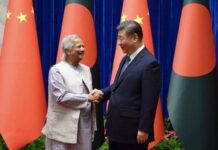China has been increasing its economic and political influence in Nepal in recent years. This includes investment in infrastructure projects, such as roads and hydroelectric power plants, as well as aid and loans to the Nepalese government. China has also been trying to build closer ties with Nepal in order to counterbalance India’s traditional dominance in the region.
Pro-China Nepalese Government
In recent years, Nepal has been seeking to strengthen its ties with China, particularly in the areas of economic development and infrastructure. The government of Nepal sees China as a key partner in its efforts to develop the country’s infrastructure and boost economic growth. China’s investment in Nepal’s infrastructure has been welcomed by the Nepalese government as an opportunity to help it address its infrastructure deficit and create jobs.
The Government of Nepal has also been trying to use China as a counterbalance to India’s traditional dominance in the region. India has long been seen as having a strong influence over Nepal’s politics and economy, and some in Nepal have sought to reduce this dependence by building closer ties with China.
However, this pro-China stance has also been met with some criticism and skepticism by some in Nepal who argue that Nepal should be cautious about becoming too dependent on China and should seek to maintain a balance in its relationships with both China and India.
Chinese Infrastructure Projects in Nepal
China has invested in a number of infrastructure projects in Nepal in recent years. Some examples include:
The Kathmandu-Terai Expressway: This is a 75.5 km long, 4-lane expressway that will connect Kathmandu to the southern plains of Nepal, known as the Terai. The project is being built with a $318 million loan from the China Exim Bank and is being constructed by a Chinese state-owned company.
The West Seti Hydropower Project: This is a 750 MW hydroelectric power plant being built on the Seti River in western Nepal. The project is being developed by a Chinese state-owned company and is being financed by a loan of $1.6 billion from the China Exim Bank.
The Pokhara Regional International Airport: This is a new international airport being built in Pokhara, a city in western Nepal. The project is being developed by a Chinese state-owned company and is being financed by a $216.5 million loan from the China Exim Bank.
China-Nepal cross-border railway: A loan of $8.3 billion cross-border railway project that would connect China and Nepal, is currently under discussion and it would be a major infrastructure project that would connect the two countries and help boost trade and tourism.
There are other projects include upgrading and maintenance of highways, building of bridges and many more.
China also provided a loan to Nepal for the construction of the Kerung-Kathmandu railway line, which is a major infrastructure project and also for many other projects as well.
High Level Political Visits
A number of high-level Chinese political leaders have visited Nepal in recent years. Some examples of such visits include:
In 2019, Chinese President Xi Jinping visited Nepal, becoming the first Chinese President to visit Nepal in 23 years. During the visit, China and Nepal signed a number of agreements on issues such as trade, infrastructure, and tourism.
In 2017, Chinese Premier Li Keqiang visited Nepal and signed a number of agreements on infrastructure projects and economic cooperation.
In 2016, Chinese Foreign Minister Wang Yi visited Nepal and signed a number of agreements on infrastructure projects and economic cooperation.
In 2016, Chinese Defense Minister Chang Wanquan visited Nepal and signed a number of agreements on defense cooperation.
In 2015, Chinese Vice President Li Yuanchao visited Nepal and signed a number of agreements on infrastructure projects and economic cooperation.
In 2022 alone, three high level visits took place. Li Zhanshu, number three in China’s leadership hierarchy and China’s top legislator visited Nepal for three days from September 12. Earlier, state councillor and foreign minister Wang Yi’s visited in March and Lin Jianchao, CPC’s international department chief, visited in July.
These visits demonstrate the growing importance that China attaches to its relationship with Nepal, and the increasing level of engagement between the two countries on a range of issues.
Chinese Claims to Nepalese Territory
There have been reports of border disputes and incursions by Chinese forces into Nepalese territory in recent years. The most notable of these incidents occurred in 2015, when Chinese border guards destroyed a makeshift border pillar set up by Nepalese border security personnel. Nepalese officials have also reported instances of Chinese troops crossing the border and building structures on Nepalese territory.
However, Chinese officials denied any such intentions and stated that the incursions were the result of misunderstandings and disagreements over the exact location of the border.
The boundary between Nepal and China is not clearly demarcated and there have been disputes over the exact alignment of the border in some areas.
Access to Chinese Ports
China has proposed to provide Nepal with access to Chinese ports as a way to boost trade and reduce Nepal’s dependence on Indian ports. This would allow Nepal to use Chinese ports to export its goods and import raw materials and other goods, which would reduce transportation costs and time, and provide Nepal with an alternative to Indian ports.
In 2017, Chinese Premier Li Keqiang visited Nepal and proposed to provide Nepal with access to Chinese ports through the development of a cross-border railway that would connect the two countries, and also signed a memorandum of understanding (MOU) to that effect. This railway would connect the Chinese city of Kerung to the Nepalese capital Kathmandu, and would also connect to other cities in Nepal.
Additionally, in 2019, Chinese President Xi Jinping, during his visit to Nepal, also proposed to build a “Trans-Himalayan Multi-Dimensional Connectivity Network” which would include upgrading and expanding infrastructure, such as roads and railways, to connect China and Nepal, and also improve access to Chinese ports for Nepal.
The proposals are still under discussion and have not been implemented yet. However, if implemented, it would help to reduce Nepal’s dependence on Indian ports, providing Nepal with an alternative route for trade and commerce.
India’s Actions to Counter Chinese Influence
India has traditionally had a strong relationship with Nepal, and has sought to maintain its influence in the country as a counterbalance to China’s growing presence. India has been trying to counter China’s influence in Nepal through a number of different strategies.
India has been providing economic aid and investment to Nepal in order to support the country’s development and infrastructure projects. India has also been encouraging Nepalese businesses to trade with and invest in India, in order to boost economic ties between the two countries.
India has been engaging with Nepal on a political level, and has been working to strengthen its ties with the Nepalese government and political leaders. India has also been working to build closer ties with Nepal’s political parties, in order to maintain a strong relationship with the country’s political establishment.
India has been working to strengthen cultural and people-to-people ties with Nepal, in order to build stronger bonds between the two countries. India has also been encouraging Nepalis to visit and study in India, in order to build closer ties between the two countries.
India and Nepal have been cooperating on security issues, such as countering terrorism and drug trafficking, in order to maintain stability in the region.
United States Stakes in Nepal
The United States has a relatively limited influence in Nepal compared to regional powers such as China and India. However, the US has been seeking to expand its engagement with Nepal in recent years in order to promote stability and security in the region.
Besides providing development and humanitarian assistance, the US has also been providing security assistance to Nepal, including training and equipment for Nepal’s military and police forces. The US has also been working with Nepal to counter terrorism and transnational crime in the region.
In recent years, the US has increased its high-level visits to Nepal, with visits from US Secretaries of State, US Ambassador to India, and US Ambassador to Nepal, and also has been providing aid and assistance in various sectors such as, health, education and more.
Nepal’s parliament ratified the US-led Millennium Challenge Corporation or MCC compact on 27 February 2022. The MCC, a US aid agency, signed a $500 million compact with Nepal to support the country in its developmental goals. Many have dubbed the MCC compact as Washington’s hedging strategy against China’s increasing aid for Kathmandu.


















